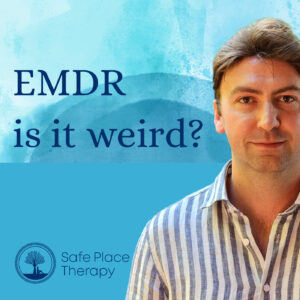EMDR Therapy Melbourne
We understand the impact trauma can have on your life and offer EMDR Therapy in Melbourne – a psychotherapy for the treatment of PTSD.
EMDR
Eye Movement Desensitisation and Reprocessing or EMDR therapy was developed in the late 1980s by Francine Shapiro. It is a highly effective form of treatment that is primarily used to address trauma and post-traumatic stress disorder (PTSD).
Numerous post traumatic stress studies have shown the effectiveness of EMDR, and it is now endorsed by the World Health Organisation. For this reason, EMDR therapy has gained a lot of interest over recent years.
Safe Place Therapy offers EMDR therapy in Melbourne with several Practitioners trained in EMDR.
EMDR Therapy sessions are also available online via Telehealth, Australia-wide.
Understanding EMDR Treatment
EMDR therapy is unlike many other forms of therapy that are used. It allows for people to reprocess painful and distressing memories through bilateral activation. The theory holds that the brain has difficulty processing trauma. The memories of traumatic experiences are stored in such a way that they continue to cause pain and distress, even years later. EMDR treatment relies on activation of the two cerebral hemispheres to allow these painful memories to be reprocessed. Once reprocessed, a traumatic memory can be stored safely so that it doesn’t cause distress and anxiety.
The EMDR Process
There are three major phases of the EMDR process: Planning and preparation, desensitisation and reprocessing, and body scan and closure. These different phases occur across a number of EMDR therapy sessions, and each point is tailored to the need of the client.
1. Planning and Preparation
Firstly, before EMDR therapy can take place, it is necessary that the therapist gain a full and proper understanding of the client’s experience. This means sharing the history of the event and any mental health issues or negative emotions that have arisen. The counsellor will then work with the client to equip them with the skills necessary for EMDR treatment. This aspect is important because it provides people with the tools needed to ground themselves during the reprocessing stage.
2. Desensitisation and Reprocessing
Under the guidance of the counsellor, bilateral activation is achieved through rhythmic eye movements or hand tapping (bilateral stimulation).
Individuals are then encouraged to explore and process memories while allowing for new information to be integrated. Your counsellor will be continuously assessing you during this stage, and will be able to pull you out if necessary.
3. Body Scan and Closure
Your EMDR therapist will help you to identify and alleviate any lingering physical tension or discomfort related to the painful memory. Lastly, the therapist will then ensure you are feeling stable and supported before finishing up the EMDR therapy session.
Conditions Treated with EMDR Therapy
EMDR has demonstrated benefits for treating:
- Trauma and PTSD: This can be complex, longstanding trauma with multiple layers, or related to a recent distressing event.
- Depression: EMDR therapy can be useful for addressing negative thought patterns and harmful core beliefs that contribute to depressive symptoms.
- Anxiety: Research has shown EMDR to be an effective tool for addressing generalised anxiety disorder, panic disorder, and social anxiety.
- Phobias: By addressing and reprocessing triggering memories, EMDR can be used to help overcome phobias.
Frequently Asked Questions
Is EMDR useful for everyone?
While EMDR is usually well tolerated, it may not be the most appropriate therapeutic method for everyone. There are a number of factors that could contribute to your suitability. Your therapist will use your first sessions with you assessing your eligibility for this form of therapy.
How many sessions does EMDR take?
EMDR therapy is highly tailored to the need of the client, and is not a linear process. There are times where you may need to return to the preparation phase before moving on further.
For this reason, there is no definitive answer as to how many sessions are required. Generally, most people require between 6 and 12 EMDR sessions, but there may be more than this required.
Therefore, it is best to maintain an ongoing discussion with your EMDR Psychologist or therapist about your overall progress.
How long do the effects of EMDR last for?
Psychological studies have demonstrated long-term effects of EMDR therapy. These effects are often enduring and many individuals report significant improvement lasting for years or more.
At Safe Place Therapy, we understand the impact trauma can have on your life and your mental health. Are you ready to start your next steps on your therapeutic journey? Contact us on 03 7049 4970 to book an appointment with an EMDR therapist.
Safe Place Therapy offers EMDR therapy in Melbourne with several Practitioners trained in EMDR.
EMDR is available online Australia-wide and at our Melbourne clinic in Footscray.
Booking is easy.
Just click the button below:
FEES: Individual Telehealth Counselling (Zoom or Phone)
please refer to individual clinician fees on the About Us page.
Get the support you need.
Reach out today!
Our Therapists

- Footscray, Online

- Footscray, Online

- Footscray, Online

- Online

- Footscray, Online

- Footscray, Online

- Footscray, Online

- Footscray, Online



